Background
The gospels of Mark, Matthew and Luke were completed before AD 70, because each recorded the prophesy of Jesus who said that the temple would be destroyed to such an extent that there would not be one stone standing on another. And this happened in AD 70. If these books were written after this event, they certainly would have recorded the fulfillment of Jesus’ prophecy. John wrote towards the end of the first century. He was the oldest surviving disciple and possibly, the only one who was not killed for his faith.
The authors of the 27 books which comprise the New Testament, were written by men who witnessed the events they wrote about, or the information was passed on to them by those who had.
By the end of the first century, AD 100, the New Testament was complete, although it was not recognized as such. The writings were being circulated and copied and being read in churches. And by the end of the second century (AD 200), as evidenced by the writings of Justin Martyr, Clement of Alexandria, Tertullian and others, Christians regarded the writings of the apostles, including Paul, the four gospels and the book of Acts, as divine scripture. In fact, right from the start as evidenced by Peter referring to Paul’s letters as being scripture (2 Peter 3:16) and Paul referring to Luke’s writings as scripture (2 Timothy 3:16 and 1 Timothy 5:17-18). The early church established the Hebrew texts as the Old Testament and the apostles’ writings as the New Testament.
Even though the writings (letters and books) were held up as inspired scripture and circulated among the churches from the time of the apostles, it was not until AD 367 that the Bishop of Alexandria, Athanasius, compiled the first canon of scripture. He did this in his Easter Letter to protect his flock from the heretical writings circulating at the time. This contained the 27 books of the New Testament. His compilation was confirmed by the councils at Hippo in 393 and at Carthage in 397, and thus the 27 books of the New Testament were settled and from then on used in all Christian denominations.
Edict of Milan
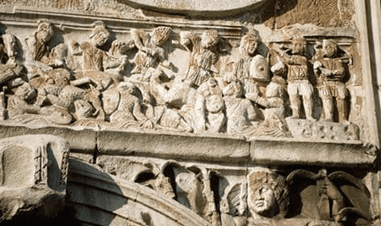 Up until the time of Constantine, Christians were brutally persecuted, but this changed with the Edict of Milan, a proclamation that permanently established religious toleration for Christianity within the Roman Empire.
Up until the time of Constantine, Christians were brutally persecuted, but this changed with the Edict of Milan, a proclamation that permanently established religious toleration for Christianity within the Roman Empire.
On October 27, 312, the night before the critical battle of Milvian Bridge (pictured), Constantine had a dream, which he saw the first two letters; the chi and the rho of Christ’s name in Greek superimposed and heard the words, in hoc signo vinces; by which you will conquer. The next morning, he ordered his men to paint this symbol, as shown, on their shields and his helmet.” They then marched into war, accordingly, as “Christian soldiers.” to victory.
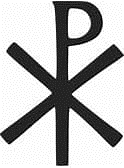 From this time forth, Christianity was the religion of the Roman Empire, with Rome being particularly significant as according to tradition, both Peter and Paul were martyred there. Constantine’s mother Helena was a Christian and to what extent this had on her son’s decision to support the church is unknown.
From this time forth, Christianity was the religion of the Roman Empire, with Rome being particularly significant as according to tradition, both Peter and Paul were martyred there. Constantine’s mother Helena was a Christian and to what extent this had on her son’s decision to support the church is unknown.
The establishment of the Church of Rome with the Pope as its head
Constantine elevated the church and power was given to its leaders and riches flowed into it. It became episcopalian, that is, government of the church by bishops.
The Council of Chalcedon had decreed that there were five dioceses with special authority, the seats of the patriarchs: Rome, Jerusalem, Alexandria, Antioch, and 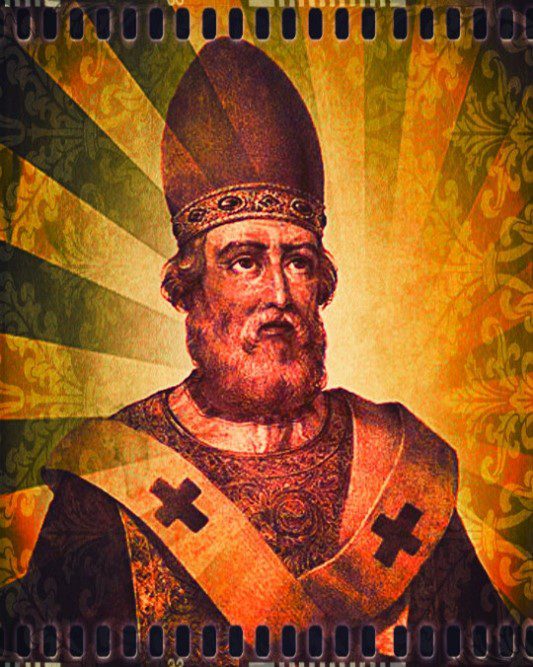 Constantinople. Apart from Rome all these cities were in the eastern half of the empire. So, from the fourth century onwards, as the two halves became politically and culturally distinct, the easterners had four apostolic sees[1] to appeal to, while the westerners had only one. Rome became more and more theologically important in the West.[2]
Constantinople. Apart from Rome all these cities were in the eastern half of the empire. So, from the fourth century onwards, as the two halves became politically and culturally distinct, the easterners had four apostolic sees[1] to appeal to, while the westerners had only one. Rome became more and more theologically important in the West.[2]
Like so much else, the transformation of the Roman see had its roots in the fourth century. One of the of the most important Roman bishops in this period was Damasus I, who reigned from 366 to 384. He did all the normal things a major bishop of the time did: he intervened in doctrinal disputes and wrote a lot of pious poetry. He was particularly devoted to the city of Rome, where he built churches and monuments. He had a high view of his own authority. He referred to Rome as the apostolic see and to himself as pontifex maximus. In earlier centuries this had been the title of the chief pagan priest of Rome, until Julius Caesar had taken it over for himself. Since then, it had been applied to the emperor. Now it referred to the bishop of Rome, and that is where the title pontiff comes from.[3]
A stylised drawing of Damasus I.
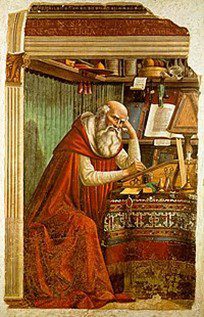 Jerome’s Latin Vulgate
Jerome’s Latin Vulgate
The first major translation of the Bible appears to be that of Jerome. Eusebius Hieronymus Sophronius, thankfully known as Jerome, took a roundabout path to becoming one of history’s most significant Bible translators. He was born in northeast Italy in 345. By the age of 29, he was a disciplined scholar and an ascetic (not allowing oneself pleasures or luxuries) Christian.
For several years Jerome lived that life in the Syrian desert, studying and transcribing the Scriptures and mastering Hebrew. He became secretary to Pope Damasus 1 in 382 and in that year, the Pope directed Jerome to translate the whole Bible into Latin which he completed in 402.
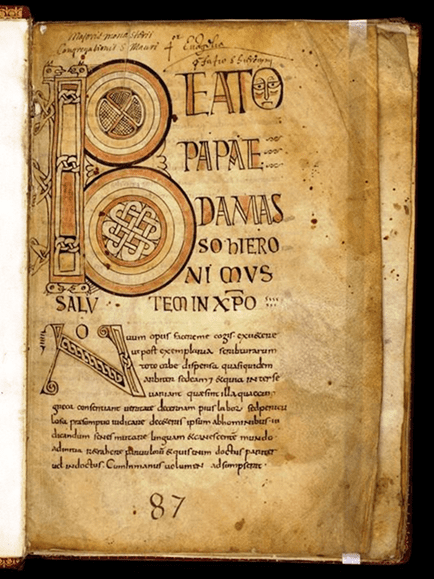 The New Testament had been written in Greek and the Septuagint, the Greek translation of the Old Testament, was used. But by Jerome’s time, Latin was spoken throughout the vast Roman empire and a good Latin Bible was needed. Although Latin translations of the Bible were in existence, they were poorly done and Jerone was the man for the job. His Latin translation became known as the Vulgate because it was in the vulgar (common) language of the people. He translated the Hebrew of the Old Testament rather than the Greek (Septuagint) into Latin and made a revision of the earlier Latin translations of the New Testament to form the complete Bible. Jerone’s Latin Vulgate became established in the Roman Catholic church where it lasted for 1,500 years.
The New Testament had been written in Greek and the Septuagint, the Greek translation of the Old Testament, was used. But by Jerome’s time, Latin was spoken throughout the vast Roman empire and a good Latin Bible was needed. Although Latin translations of the Bible were in existence, they were poorly done and Jerone was the man for the job. His Latin translation became known as the Vulgate because it was in the vulgar (common) language of the people. He translated the Hebrew of the Old Testament rather than the Greek (Septuagint) into Latin and made a revision of the earlier Latin translations of the New Testament to form the complete Bible. Jerone’s Latin Vulgate became established in the Roman Catholic church where it lasted for 1,500 years.
Translation errors
Dutch scholar and prolific writer, Desiderius Erasmus (Erasmus of Rotterdam) (1465-1530) was so grieved by the errors in Jerome’s Latin Vulgate that he decided to produce his own version of the scriptures (NT), in Latin, but this time from the early Greek. Apparently, his publisher (Johann Froben of Basel) urged him to produce a Greek version as well, since none was in existence. He hurriedly did this and in 1516 his Latin and Greek translations were published side by side.
The translation errors that grieved Erasmus and they may have been added deliberately, underpinned the church’s hierarchical order and its doctrines. For example:
In twenty places Jerome translated the word metanoia as “do penance” instead of “repent”
For example, Mark 1:15 the Vulgate quotes Jesus as saying, Do penance, and believe the gospel. But Erasmus quoted Jesus as saying, Repent and believe the gospel.
The fact is that salvation is a gift and to be able to accept it, we must repent. We do not have to go to confession and do acts of penance and make amends to God for our sins.
Hebrews 10:12 states; But this man (Christ), after he had offered one sacrifice for sins forever, sat down on the right hand of God; A once only transaction. Jerome changed it to, But this man offering (a continuous present) for sins,
Virgin Mary worship is underpinned by such verses as: Genesis 3:15 where God states in reference to the promised Redeemer: I will put enmity between thee and the woman, and between thy seed and her seed: he shall bruise thy head and thou shalt bruise his heel. The Vulgate replaces he shall bruise with she shall bruise. And it finishes with; thou shall lie in wait for her heel.
Again, in Luke 1:28 when the angel informs Mary of her destiny, he says; you are highly favoured. Whereas the Vulgate replaces highly favoured with full of grace. Highly favoured means that Mary was a mere mortal who God had chosen, whereas full of grace gives the impression of her as being elevated.
These and other errors gave rise to Mary worship and her perpetual virginity.
Jerome’s Vulgate was effectively the only Bible used from its inception, through the Middle Ages and up until the revised translations of Erasmus; eleven hundred years later. It is still having use in the Roman Catholic Church,
Also of note, Jerome’s Vulgate contains the longer version of Mark’s gospel that is Mark 16:9-20. These additional verses are not found in the oldest Alexandrian manuscripts like Codex Vaticanus and Codex Sinaiticus. Some second century Christians may have referred to these later chapters of Mark. The position is uncertain.
Apocrypha.
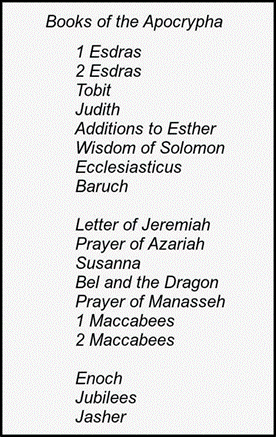 These are books that were written from about 300 BC to about AD 200 they were never considered to be inspired even though they contained some truth, they contained theological errors as well. Therefore, they are not part of the New Testament. There are 7 or 12 depending on how they are divided.
These are books that were written from about 300 BC to about AD 200 they were never considered to be inspired even though they contained some truth, they contained theological errors as well. Therefore, they are not part of the New Testament. There are 7 or 12 depending on how they are divided.
The apocrypha are included as a separate part of the Roman Catholic Bible (Jerome’s Latin Vulgate and its successor the Doway/Rheims Version, which persisted with the same errors), and are placed between the Old and New Testaments.
They were included in the 1611 edition of the King James Bible, and again between the testaments.
The following are examples of the types of errors found.
Tobit 12:9 states. For almsgiving (the giving of money) saves from death and purges away every sin. Those who give alms will enjoy a full life.
God’s grace alone saves sinners, Ephesians 2:8-9.
2 Maccabees teaches the doctrine and practices associated with purgatory like praying for the dead and collecting financial offerings for the church so that the dead can be saved from sin.
There is no purgatory in the Bible.
Baruch 3:4 reads O Lord Almighty the God of Israel, hear now the prayer of the dead of Israel and the prayer of their children that have sinned before thee and have not harkened to the voice of the Lord their God, wherefor evils have cleaved fast to us.
This is contrary to scripture. Once we die, we are assigned to one of two places, heaven, or hell.
In 1881, due to the influence of textual critics, Westcott and Hort, the Apocrypha was removed from non- Catholic Bibles.
Codex Vaticanus and Codex Sinaiticus
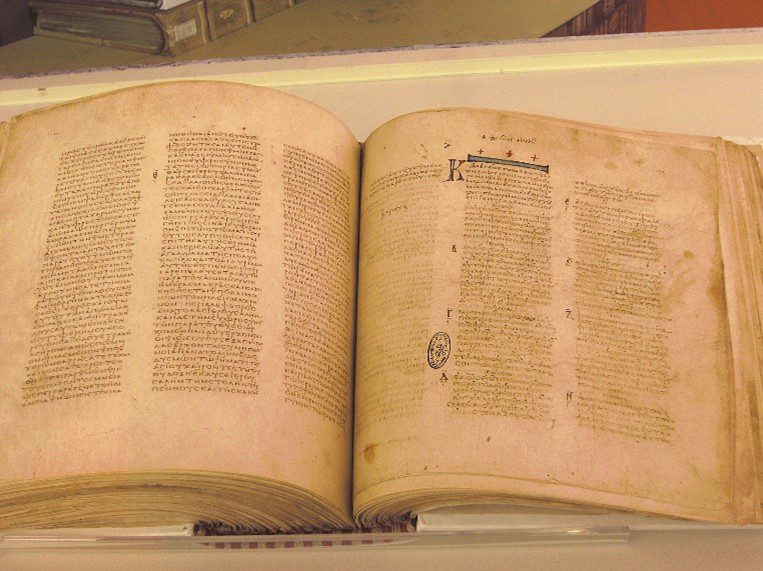 The Codex Vaticanus is one of the oldest extant manuscripts of the Greek Bible (Old and New Testament), one of the four great uncial codices. The Codex is named after its place of conservation in the Vatican Library, where it has been kept since at least the 15th century. It is written on 759 leaves of vellum in uncial letters and has been dated palaeographically from the early to mid-4th century.
The Codex Vaticanus is one of the oldest extant manuscripts of the Greek Bible (Old and New Testament), one of the four great uncial codices. The Codex is named after its place of conservation in the Vatican Library, where it has been kept since at least the 15th century. It is written on 759 leaves of vellum in uncial letters and has been dated palaeographically from the early to mid-4th century.
The manuscript became known to Western scholars because of correspondence between Erasmus and the prefects of the Vatican Library. The Codex’s relationship to the Latin Vulgate was unclear and scholars were initially unaware of the Codex’s value. This changed in the 19th century when transcriptions of the full codex were completed. It was at that point scholars realized the text differed significantly from the Vulgate and the Textus Receptus which is a revision of Erasmus’ earlier work, and it was based on the much later Majority text.
Codex Sinaiticus, along with Codex Vaticanus is an Alexandrian text-type manuscript[4] written in the 4th century in uncial letters on parchment. Current 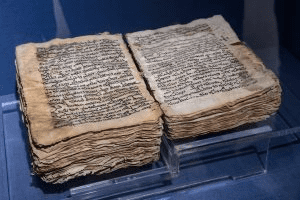 scholarship considers the Codex Sinaiticus to be one of the best Greek texts of the New Testament, along with that of the Codex Vaticanus. It was discovered by Tischendorf in a Raiders of the Lost Ark fashion (see my article on how Tischendorf discovered it: https://www.adefenceofthebible.com/2017/03/14/tischendorfs-great-manuscript-find.) of the Sinaiticus text, the Codex Vaticanus was unrivaled.
scholarship considers the Codex Sinaiticus to be one of the best Greek texts of the New Testament, along with that of the Codex Vaticanus. It was discovered by Tischendorf in a Raiders of the Lost Ark fashion (see my article on how Tischendorf discovered it: https://www.adefenceofthebible.com/2017/03/14/tischendorfs-great-manuscript-find.) of the Sinaiticus text, the Codex Vaticanus was unrivaled.
The Codex Sinaiticus came to the attention of scholars in the 19th century at the Greek Orthodox Monastery of Mount Sinai, with further material discovered in the 20th and 21st centuries. Although parts of the Codex are scattered across four libraries around the world, most of the manuscript today resides within the British Library. Since its discovery, study of the Codex Sinaiticus has proven to be extremely useful to scholars for the purposes of biblical translation.
Codex Sinaiticus is a complete copy of the New Testament, Vaticanus has a few books missing.
Codex Vaticanus and Codex Sinaiticus predate Jerome’s Latin Vulgate by 50 to 75 years and they vary significantly from it in key theological areas.
Summary
The Bible of the Roman Catholic church differs from that of the protestant Bible in two major ways. It is based on Jerone’s Latin Vulgate which contains many theological errors as shown, and it contains the books of the apocrypha which have led to heretical practiced such as purgatory and giving money to the church for it to pray a loved one from purgatory to heaven and, as well, the elevation of the status of Mary the mother of Jesus.
Protestants can have great confidence in our Bible as all, except for the King James and the New King James, are based on the earliest copies of scripture found in Codex Vaticanus and Codex Sinaiticus and they do not contain the Apocrypha.
[1] The word “see” comes from the Latin word sedes, meaning ‘seat’, which refers to the episcopal throne (cathedra). The term “Apostolic See” can refer to any see founded by one of the Twelve Apostles, but, when used with the definite article, it is used in the Catholic Church to refer specifically to the see of the Bishop of Rome, whom that Church sees as the successor of Saint Peter. [2] Jonathan Hill, The New Lion Handbook The History of Christianity, Lion, 2007, page 167. [3] Jonathan Hill, page 168. [4] Of the three major Greek text types, Byzantine (often referred to as the Majority Text), Western and Alexandrian, the Alexandrian is the oldest by far.
